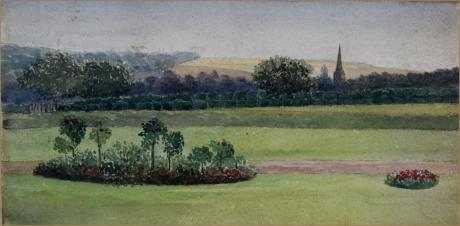inscribed and dated in the margin " View of Sharnbrook Church from Souldrop Rectory 1868"
In August 1987 the former rectory was listed by English Heritage as Grade II, of special interest. The lisitng dates the building to the late 17th century in origin though “much altered” in the 19th century. As we will see, these dates do not quite match the history of the property from the surviving archives. The building is partly roughcast limestone rubble, with a Welsh slate roof. It comprises two storeys and attics. The property known as Spinney Hill was formerly part of the Rectory but now forms a separate house. It is 19th century, again built of limestone rubble and Welsh slates. It comprises two storeys and attics.
The first reference to the parsonage at Souldrop is in 1538 when a presentment was made to the Archdeaconry Court that it was out of repair [ABC2 page 47]. Two terriers survive from the early 18th century – one from 1702 [ABE I] the other from 1708 [ABE II]. At this time the Rectory was a stone-built structure with a thatched roof. Downstairs it comprised a kitchen with a stone floor, a hall with a board floor and a buttery with floors of stone, brick and earth. Three chambers lay upstairs. There were a number of outbuildings: a six-bay barn, partly stone, partly oak with a thatched roof; a one bay barn, wooden with a thatched roof; a barn “floored with a movable chamber for grain”; a two-bay thatched barn and a one-bay stable.
In 1793 the rector asked for a faculty and stated that he found: “the Parsonage house of Knotting in a very ruinous Condition without any Conveniences of Offices ir Land, excepting a small Orchard and the Church yard. That at Souldrop there was no parsonage house, the old one having been destroyed some years past but that there was a new and very good Barn and Stable erected on the Glebe farm consisting of about Sixty five Acres of Land in the parish of Souldrop which farm was allotted to the Rector by a late Inclosure in lieu of Tithes in kind, according to an Act of Parliament obtained for that purpose. That the Glebe Land lieth contiguous to the Village of Souldrop on which account and because the parish of Souldrop is a larger village than that of Knotting and in a better Situation, Your Petitioner, consulting more the advantage of the said united Rectories than his own private Convenience, humbly prayeth your Worship that a Licence or faculty mat be granted under the Seal of Office to empower him to take down the old parsonage house of Knotting and t remove the materials thereof to Souldrop for the purpose of erecting a new and more commodious parsonage house at that Place which is to consist of at least three good Rooms on the first floor and four on the second with suitable out-offices and Conveniences” [ABF3/122]. The faculty was duly granted.
In August 1801 the rector wrote to the Duke of Bedford’s agent John Wing (the duke being Lord of the Manor and holding the advowson at Souldrop): “As I am now getting very fast forward with the Building of my House at Souldrop and should be desirous of taking the first opportunity of planting and laying out the Ground immediately adjacent to it, I should take it as a favour if when you next come to Bedford you would let me have the pleasure of your Company at Sharnbrook when I would point out to you the part of Mr Christ’s Close between the House and the Church, which I have requested the favour of the Duke of Bedford to accommodate me with”.
“Mr Christ says he would have no objection to my entering upon it at Michaelmas next on my making him a proper compensation for any immediate advantages attached to the land. I need not add that I shall be happy to be directed entirely by your Judgement in doing whatever may be conceived right and proper” [R4/534/20/5].
In 1856 a new Rector, George Digby Newbolt, arrived. He kept commonplace books during his incumbency and noted on arrival: “The Rectory House at Souldrop having fallen into great decay and being unable to obtain any dilapidation money from the representatives of the late Incumbent, Mr Newbolt was compelled to borrow the sum of £500 from the Governors of Queen Anne’s Bounty in order to repair and enlarge the same”
“Mr Wing of Bedford undertook the work and on the first day of April 1857 Mr Newbolt took up his residence at the Rectory House, having during the previous months resided at a Farm at Knotting Green”. In 1877 the tithe barn was converted to stables by Bedford architect John Day.
The Rating and Valuation Act 1925 specified that every building and piece of land in the country was to be assessed to determine its rateable value. The valuer visiting the Rectory, in 1927 [DV1/C167/3] found that the rector lived there rather than renting it out. The valuer commented: “No water. Have to fetch it half mile – soft water well only, half-acre garden sold two years ago”.
Downstairs were: a hall (“nice”); a den room; a pantry; a kitchen (“big”); a scullery; back stairs; a drawing room facing south-east and a study. Upstairs were three bedrooms, a boxroom, a dressing room, a bedroom over the drawing room, a bedroom over the study and a bedroom over the hall. The second floor contained four attic bedrooms of which one was used. Outside was a brick, stone and thatched garage and two stores (“good”). The valuer summed-up: “Quite a good house – would let but for water. Nice garden. Too big for living”.
In 1953 the Vicar of Sharnbrook also became priest in charge at Knotting and Souldrop. From 1955 the two parishes have shared an incumbent, leading to the Rectory at Souldrop being sold.

